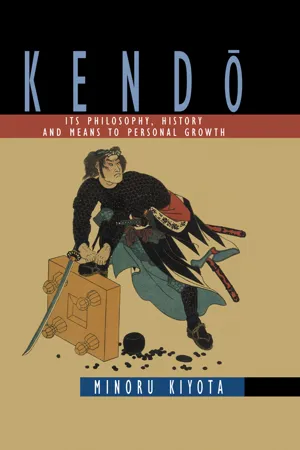
This is a test
- 172 pages
- English
- ePUB (mobile friendly)
- Available on iOS & Android
eBook - ePub
Kendo
Book details
Book preview
Table of contents
Citations
About This Book
Kendo is the modern version of Japanese swordsmanship. This book focuses on kendo's philosophical infrastructure, its history and its potential contributions to personal growth. The purpose of this work is to describe the discipline of swordsmanship cultivated by the samurai in medieval and premodern Japan and to show the relevance of that discipline today.
Frequently asked questions
At the moment all of our mobile-responsive ePub books are available to download via the app. Most of our PDFs are also available to download and we're working on making the final remaining ones downloadable now. Learn more here.
Both plans give you full access to the library and all of Perlego’s features. The only differences are the price and subscription period: With the annual plan you’ll save around 30% compared to 12 months on the monthly plan.
We are an online textbook subscription service, where you can get access to an entire online library for less than the price of a single book per month. With over 1 million books across 1000+ topics, we’ve got you covered! Learn more here.
Look out for the read-aloud symbol on your next book to see if you can listen to it. The read-aloud tool reads text aloud for you, highlighting the text as it is being read. You can pause it, speed it up and slow it down. Learn more here.
Yes, you can access Kendo by Kiyota in PDF and/or ePUB format, as well as other popular books in Ciencias sociales & Antropología. We have over one million books available in our catalogue for you to explore.
Information
Index
This index includes terms found in the body of this work as well as in the footnotes but not in the endnotes. Terms are classified into categories as indicated below:
Technical Terms
Abrupt doctrine, 36, 37
Ahimsā, 33
Aikidō, 1, 6
Anātman, 3
A-ware, 85
Bandō musha no narai, 77
Bodhimanda, 14, 15
Body-mind integration, 5, 6, 7
Bō, 19, 20
Bōgu, 1, 12, 20, 64, 65, 69
Bodhicitta, 20, 23, 24
Bokken, 19
Bokutō, 19, 47, 48, 49, 50, 52, 62, 64
Buddha, 22, 32, 53, 55
Buddhism, ix, 6, 33, 35, 86, 105, 109
Buddhist, 1, 34, 35, 85, 89, 107
Budō, 15
Bunbu-ryōdō, xi, 103, 108
Bushi, x, 75
Bushidō, x, 29, 32, 73, 74, 75, 76, 77, 79, 83, 84, 85, 88, 99, 101, 103, 107, 110
Catholic (Catholicism), 57
Chi, 29
Ch’i, 5
Chiken-in (Jñāmusti-mudrā), 25
Christianity, Christian, Christians, 57, 87, 88
Chūdan, 7 , 8, 9
Chūshinguro (seeTexts, Forty-seven Rōnin
Chu-tzu, 63
Confucian, Confucianism, neo-Confucianism, ix, 86, 88
Coup de grace, 42
Daimyō, 27, 40, 41, 42,...
Table of contents
- Cover
- Half Title
- Title Page
- Copyright Page
- Table of Contents
- List of Illustrations
- Preface
- I: What is Kendō?
- II: The Impact of Buddhist Thought on the Development of Swordmanship
- III: The Development of Swordmanship
- IV: The Development of Bushidō, the Code of the Samurai
- V: The Modern Period
- Epilogue
- Appendix: Ryū Lineages
- Endnotes
- Selected Annotated References
- Selected Glossary
- Index